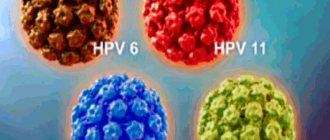Features of HPV type 39
There are about 100 genotypes of papillomavirus. Some of them are considered oncogenic. This means that during infection, the risk of transformation of papillomas from benign to malignant increases many times over. The 39 genotype under consideration is also included in this group. Malicious particles tend to seize control of intracellular processes. Viral DNA penetrates into the perinuclear space of the cell. In this state, it forms an episome.
During the division process, daughter cells will also contain viral DNA. Oncogenic genotypes, including papillomavirus 39, contain proteins E6 and E7, which are involved in processes that provoke the development of a pathological condition (oncology). The main danger of HPV is the absence of manifestations during the incubation period, which varies from 6 months to several years.
Reasons for appearance
Human papillomavirus 39 is often in a dormant state, which is facilitated by normal immunity, which suppresses the activity of harmful particles, and the absence of factors that provoke its development. If these conditions are violated, intensive division of cells containing viral DNA begins. As a result, excess tissue is formed on the body (external integument, mucous membranes). Depending on the state of the human body, neoplasms appear quickly or develop over a long period.
Genotype 39 is a type of virus that provokes the formation of genital warts and flat papillomas. In most cases, the growths are localized in the genital area. The virus can affect both women and men, but HPV is more often found in the first group. The location of the tumors will depend on how the infection occurred. Less commonly, growths appear on the hands, face, neck, etc.
Routes of infection
There are only a few possible ways of spreading HPV genotype 39. Routes of infection:
- sexual;
- contact and household;
- vertical.
The first option is the most common. This is due to the fact that the type of infection in question penetrates the host’s body through direct contact with the carrier. This means that the risk of infection from a sexual partner is much higher than, for example, through contact and household methods, in which harmful particles do not remain viable for long on hygiene items (towel, razor, underwear).
During sexual intercourse, infection occurs provided that there are microdamages and injuries on the outer integument and mucous membranes. Then the way for the virus to enter the body of a woman or man is open. If the integrity of the skin and mucous membranes is not compromised, even upon contact with a carrier, a person will not become infected. However, barrier contraception should be used, since it is impossible to reliably know whether there are microdamages to the outer integument.
A condom does not provide complete protection against infection. With its help, it is only possible to reduce the likelihood of infection. The least common route of transmission of HPV is from mother to child during childbirth.
Factors that increase the risk of HPV 39 infection
When harmful particles come into contact with the skin and mucous membranes, the development of a pathogenic process occurs only when a number of conditions are met. First of all, a decrease in immunity is noted, which is a consequence of the influence of such factors:
- hormonal imbalance - occurs during menopause, pregnancy, lactation, and also in the case of the development of certain diseases;
- intense workload, in particular physical labor, professional sports;
- deterioration in the quality of sleep, which occurs along with a change in diet, then the human body does not receive vitamins and nutrients in sufficient quantities;
- frequent colds;
- development of chronic diseases, periodic exacerbation of the condition;
- presence of other STDs (HIV, herpes, etc.);
- drinking alcohol in excess, smoking;
- frequent abortions.
Violation of the integrity of the mucous membrane of the vagina and cervix, for example, if dysplasia or neoplasia develops, contributes to infection. This may be the reason for the activity of another strain of HPV that entered the woman’s body earlier, since a combination of infections of two types is often detected.
Human papillomavirus type 18, HPV DNA 18 t.
Human papillomavirus type 18, HPV 18
— qualitative detection of human papillomavirus of high oncogenic risk in scrapings of the urogenital tract using the polymerase chain reaction method with real-time detection. The PCR method with real-time detection of results allows you to determine the amount of DNA of clinically significant HPV types in a sample.
Human papillomavirus (HPV)
is a widespread infectious disease of the genitourinary organs, which can cause cervical cancer in women and squamous cell carcinoma in men.
Different types of HPV cause the development of:
- cervical, vulval, vaginal dysplasia of the cervix;
- pre-invasive and invasive cancer of the cervix, cancer of the vagina and perianal area;
- genital warts, urinary tract;
- genital warts.
Routes of spread of infection
The main route of transmission of HPV is sexual, but cases of household transmission of infection have been described. Women and men are infected at the same rate. In approximately 70% of those examined, HPV is detected in both sexual partners. Intrauterine infection is possible.
According to some researchers, the frequency of infection with the virus is directly proportional to the number of sexual partners: with one partner, HPV is detected in 17-20% of women, with 5 or more partners - in 70-80%.
Incubation period
The incubation period can last from 2 months to 2–10 years. HPV is characterized by a latent course of the disease, in which there are no clinical manifestations and no changes are detected during colposcopic, cytological and histological examination. In 30% of cases, the virus can be cleared within 6–12 months. Diagnosis of latent HPV infection is carried out only by PCR.
Clinical manifestations
HPV can affect the epithelium in different ways: contribute to the emergence of benign formations (papillomas, condylomas) or the combination of papillomavirus DNA with the cell gene, which leads to dysplasia and neoplasia, and subsequently to cancer. The most common area of cancer localization is the transition zone of the cervix to the cervical canal.
Clinical forms of human papillomavirus infection are found in 40–60% of men who are sexual partners of infected women. Their lesions are caused by the same types of HPV as women. In 2/3 of cases, characteristic rashes appear on the skin and mucous membranes of the genital organs.
HPV type 18 can cause cancer. HPV 18 causes cancer of the cervix, external genitalia, vagina, anal area, and flat condylomas. The danger of the disease is that its manifestations appear only a couple of months after infection. At the same time, type 18 develops and infects the body faster than type 16 virus.
Indications for the study:
- persons being tested for other STIs;
- women with a burdened obstetric and gynecological history - manifestations of transforming dysplasia to varying degrees;
- men according to clinical indications;
- weakened immunity;
- preventive screening studies.
With timely examination and proper treatment, the risk of degeneration of high-risk HPV cancer can be minimized. Preparation Men
Before taking a urogenital scraping, it is recommended to refrain from urinating for 1.5–2 hours.
Women
Submitting scrapings is not allowed on menstrual days. Avoid taking antibiotics for two weeks, and vaginal suppositories, tampons, spermicides three days before collection. One day before the test, you should not have sexual intercourse. You should not douche on the eve of the examination. After an ultrasound using a transvaginal probe, at least 48 hours must pass.
Interpretation of results
The format for issuing the result of HPV type 18 is detected/not detected.
Reasons for the positive result:
- the presence of HPV genotype 18 in the test material, which is associated with a high risk of developing cervical cancer and other neoplasms of the anogenital area.
Reasons for negative results:
- the absence of HPV genotype 18 in the test material, which does not exclude the possibility of infection with HPV of other genotypes.
What can influence the result?
- A false negative result is possible if the material is collected and stored incorrectly, as well as if the virus content in the material is below a detectable level.
- A false positive result may be due to contamination of the material.
Important Notes
- HPV infection does not always lead to cervical cancer.
- Simultaneous infection with several HPV genotypes is possible.
- The result of the analysis must be interpreted taking into account the conclusions of cytological and histological studies.
The course of the disease and its complications
As soon as papillomavirus type 39 begins to develop under the influence of unfavorable conditions, as a result of intensive cell division, the formation of genital or flat condylomas occurs. This is the first symptom of the disease. At the initial stage, neoplasms on the skin/mucous membranes are benign. This condition can persist for a long period. In this case, formed human papillomas in women and men do not pose a danger.
When cancer cells appear, the growths transform and gradually become malignant. This process causes dysplasia, neoplasia of the cervix and surrounding tissues. The main factor that leads to this outcome is the regular deformation of the growths. This happens during sexual intercourse. This means that the risk of degeneration of the tumor increases with the appearance of genital warts and genital warts in the perineum, on the mucous membranes of the internal genital organs.
In this case, the following symptoms may appear:
- pain during sexual intercourse;
- burning when urinating;
- uncharacteristic discharge from the genitals: with changes in color, structure, volume;
- discomfort;
- a change in the color of the mucous membranes of the cervix, cervical canal and surrounding tissues, with redness noted, granularity appears, and the process of ulceration begins.
When HPV type 39 is detected in men, papillomas form on the penis (head and body) and scrotum. Moreover, a common situation is when growths are located near the entrance to the urethra, which makes urination difficult. If the integrity of the neoplasm is violated, a secondary infection may occur. Another complication of HPV infection is the development of Bowen's disease.
A study aimed at detecting the genetic material (DNA) of the human papillomavirus of high carcinogenic risk with genotyping of 16 and 18 types of the virus. 14 HPV genotypes are detected based on the polymerase chain method in real time with multiplex detection (Roche Cobas 4800).
Synonyms Russian
Human papillomavirus of high carcinogenic risk; HPV of high carcinogenic risk; DNA [real-time polymerase chain reaction, Roche Cobas 4800].
English synonyms
Human Papillomavirus; HPV; high carcinogenic risk; DNA.
What biomaterial can be used for research?
A smear mixed from the cervical canal and the surface of the cervix.
General information about the study
Human papillomavirus (HPV or HPV) is a family of DNA viruses that cause various lesions of the skin and mucous membranes of humans. More than 100 types of HPV are known, which can be associated with the appearance of warts, papillomas, genital and flat condylomas, precancerous changes (dysplasias) and cancer of the cervix, vagina, vulva, rectal cancer, penis and neoplasms of some other localizations (for example, oropharyngeal carcinoma). The source of infection is a sick person or a virus carrier. The main route of transmission of infection is sexual intercourse. Infection through common household items and vertical transmission, from an infected woman to a child during pregnancy or childbirth, is also possible.
There are HPV genotypes, infection of which leads to the development of benign processes, and those that have a high risk of malignant degeneration. HPV genotypes 1, 2, 3, 4, 5, 10, 28, 49 are non-oncogenic; genotypes 6, 11, 13, 32, 34, 40, 41, 42, 43, 44 have a low oncogenic risk; genotypes 26, 30, 53, 65 have an average oncogenic risk; genotypes 16, 18, 31, 33, 35, 39, 45, 51, 52, 56, 58, 59 belong to HPV of high carcinogenic risk and 66, 68 belong to types of probable risk for humans. The genome of oncogenic HPV types contains regions responsible for the synthesis of certain proteins. Oncoproteins E6 and E7 suppress the processes of apoptosis (programmed cell death) in cells with altered genetic material. They play a large role in the development of malignant tumor processes. Regions of the genome L1 and L2 are responsible for the synthesis of structural proteins of the capsid shell of the virus.
Infection with highly oncogenic HPV types may be associated with the development of cervical intraepithelial neoplasia (CIN) and cervical cancer in women. Cervical cancer ranks third in the structure of the incidence of malignant neoplasms among women in Russia. In most cases, 90%, the oncological process is represented by squamous cell carcinoma, less often by other histological variants (adenocarcinoma and adenosquamous cell carcinoma). Long-term persistence of the virus and high levels of virus content may be associated with the severity of the disease.
The main method of screening for cervical cancer and precancerous conditions is a Papanicolaou cytology test (Pap smear). According to generally accepted recommendations, it is performed on all women over the age of 21, regardless of the age of onset of sexual activity, with an interval of 3 years until the age of 65. For women aged 30-65 years, an alternative screening program can be used at 5-year intervals, involving simultaneous two tests: Pap cytology and HPV DNA testing using the polymerase chain reaction method. It should be noted that at a young age, HPV can be spontaneously eliminated from the body and cannot be detected using modern methods. Moreover, in 70% of cases during the first year and in 90% of cases two years after infection, self-healing is possible.
The use of combined diagnostics (cytological examination and DNA testing) increases the efficiency of detection of precancerous conditions, grade 2 and 3 CIN, and cervical cancer.
Modern diagnostic methods include the real-time polymerase chain reaction method (real-time PCR). Polymerase chain reaction is a molecular diagnostic method that allows one to identify the genetic material of the pathogen under study. It is characterized by high rates of diagnostic sensitivity and specificity, speed of obtaining the final result and accessibility. A special feature of the method is the ability to detect DNA (deoxyribonucleic acid) of the virus even when its content in the biological material under study is low. The method is based on a multiple increase in the number of copies of a DNA region specific to a given pathogen.
The Roche Cobas 4800 analyzer and test system combines automated sample preparation and detection of 14 HPV genotypes based on real-time PCR with multiplex detection. This allows genotyping and determination of the presence of HPV 16 and HPV 18, as well as a pool of 12 HPV types with high carcinogenic risk (31, 33, 35, 39, 45, 51, 52, 56, 58, 59, 66, 68). Human β-globin is used as an internal reaction control. The use of the Roche Cobas 4800 real-time PCR method for screening determination of HPV genotypes with high carcinogenic risk is recommended, tested and clinically proven. The use of this diagnostic method makes it possible to simultaneously genotype the virus for HPV 16 and HPV 18. These types of virus are among the most carcinogenic and are associated with a clinically significant risk of developing grade 3 CIN or cervical cancer. The HPV 16 genotype is more common in squamous cell carcinoma, and HPV 18 in adenocarcinoma. Thus, it is possible to identify HPV genotypes of high carcinogenic risk, predict the risk of developing infection, CIN and cervical cancer, as well as determine tactics, monitor therapy and assess the possibility of relapse after treatment.
What is the research used for?
- To assess the risk of developing processes and diseases associated with HPV: cervical intraepithelial neoplasia (CIN grades 2 and 3) and cervical, vaginal, vulvar cancer, rectal cancer, oropharyngeal carcinoma;
- For screening diagnosis of HPV genotypes of high carcinogenic risk (16, 18, 31, 33, 35, 39, 45, 51, 52, 56, 58, 59, 66, 68);
- For differential diagnosis and genotyping of HPV 16 and 18, with determination of the DNA concentration of these types of virus;
- To monitor HPV infection and predict its course;
- To monitor the effectiveness of treatment of precancerous diseases associated with HPV;
- To determine tactics, monitor therapy and assess the possibility of relapse after treatment
When is the study scheduled?
- With clinical manifestations and suspicion of the development of an oncological process in the anogenital area;
- In the presence of condylomas, warts of the genital tract and other morphological changes in the epithelium of various localizations;
- When screening for cervical cancer in women over 30 years of age as part of a combined diagnosis (cytological examination and DNA testing using the polymerase chain reaction method);
- When HPV of an unspecified genotype is detected;
- When detecting cytological changes in a smear for atypia, during a cytological examination of a Papanicolaou smear, in a histological specimen;
- When monitoring those infected with HPV;
- In the treatment of cancer and precancerous conditions associated with HPV;
- When determining tactics, monitoring therapy and assessing the possibility of relapse after treatment.
What do the results mean?
Reference values
| Reference values | |
| HPV DNA type 16 | Not detected |
| HPV DNA type 18 | Not detected |
| HPV DNA types 31-68 | Not detected |
Reasons for the positive result:
- Infection with HPV of high carcinogenic risk (16, 18, 31, 33, 35, 39, 45, 51, 52, 56, 58, 59, 66, 68 genotypes);
- Increased concentration of HPV DNA of 16 and/or 18 genotypes.
Reasons for negative results:
- Absence of infection and genetic material of HPV of high carcinogenic risk in the studied biomaterial.
Diagnosis of virus strain 39
The goal of the research is to obtain more information about HPV DNA (what it is, how cell structure changes). Considering that the infection most often affects the genitals, if condylomas are detected in the perineum, it is recommended to consult a specialized specialist.
The gynecologist should examine the cervix and cervical canal using a colposcope. A general blood test does not provide the ability to determine strains of papillomavirus, but with its help it will be possible to identify changes in the main indicators of blood composition.
Papillomavirus genotype 39 is detected using the following methods:
- PCR. This study allows us to determine the type of infection. Among the existing methods, this technology makes it possible to find out whether the virus that has infected a person is oncogenic.
- Cytological examination of a smear from the urogenital canal. This method allows you to study the structure of the cells of the mucous membrane of the genital organs for the presence of pathological changes.
- The Digene test is a recent development, with the help of which it is possible not only to determine the presence/absence of harmful particles of type 39, but also to determine the concentration of the virus.
- Biopsy with further histology. In this case, biomaterial is taken to determine the nature of the disease: benign, malignant.
The HPV type in men is detected less frequently, and colposcopy is not used, but other types of studies are allowed: PCR, digene test, cytology, histology.
References
- Cervical cancer. Clinical guidelines, 2022. - 44 p.
- Rakhmatulina, M.R., Sokolovsky, E.V., Perlamutrov, Yu.N. and others. Federal clinical recommendations for the management of patients with anogenital (venereal) warts. Russian Society of Dermatovenereologists and Cosmetologists, 2015. - 27 p.
- Folyak, E.V., Sokolova, T.M., Makarov, K.Yu. and others. Papilloma-viral infection of the urogenital tract of women (epidemiology, clinical and pathogenetic features, diagnostic methods, treatment, prevention): information and methodological manual. - Novosibirsk: Vector-Best, 2010. - 88 p.
- Piana, A., Sotgiu, G., Cocuzza, C. et al. High HPV-51 prevalence in invasive cervical cancers: results of a pre-immunization survey in North Sardinia, Italy. PLoS One, 2013. - Vol. 8(5).
Treatment methods
The doctor must convey to the patient that it is difficult to completely get rid of the infection. To destroy the virus, it is necessary to influence it with drugs, but it is also important to exclude factors that contribute to the activation of harmful particles: increased physical activity, hormonal disorders, consumption of alcohol in excess quantities, etc. If immunity is maintained at a high level, the body will cope with the virus on its own. infection.
Tobacco and alcohol use significantly increase the risk of tumors.
Treatment of HPV type 39 involves the need to remove growths. This strain is oncogenic, which means that the process of transforming the neoplasm into a malignant tumor can begin at any time. In addition, papillomas are regularly deformed, which also contributes to the development of cancer.
Pharmacy drugs
When infected with HPV, therapy is carried out in two directions. Medicines that your doctor may prescribe:
- Antiviral drugs. The drugs in this group do not help cure the virus, but with their help it becomes possible to prevent the further spread of papillomas and the growth of existing tumors. Antiviral drugs block the activity of HPV, which leads to the cessation of the process of division of harmful particles. Such medicines can be of two types: for external and internal use.
- Immunostimulants/immunomodulators. This group of drugs helps to activate the body's defenses. Thanks to this, a person acquires the ability to independently fight the virus. However, immunomodulatory drugs should be used with caution. Such drugs, if used uncontrolledly or with incorrect dosage calculations, can provoke the development of autoimmune diseases.
Professional removal
When infected with human papillomavirus type 39, it is mandatory to cleanse the affected mucous membranes and skin of growths. Removal of formations can be done in any of the following ways:
- Laser therapy. In this case, a radiation beam is used, which allows you to get rid of growths without causing pain or bleeding.
- Cryodestruction. The papilloma is removed using an applicator with liquid nitrogen.
- Electrocoagulation. The procedure is performed using a special device that produces high-frequency current.
- Radio wave therapy. This is a non-contact method, which is considered the most preferable when affecting mucous membranes.
- Using a scalpel. This method is used in cases where it is necessary to remove large papillomas.
Strengthening the immune system
Simultaneously with drug therapy and the procedure for excision of tumors, it is necessary to increase protective forces. For this, your doctor may recommend a vitamin complex. It is necessary to adjust the diet, introducing healthy foods rich in vitamins.
In addition, physical activity should be normalized; in case of physical inactivity, on the contrary, gymnastics is indicated. It is important to eliminate stress and avoid frequent overwork. Sleep should be normalized. Without these recommendations, treatment methods will not give the desired results. After a while, the infection reactivates.
Treatment of HPV with folk remedies
Along with drug therapy, improvised methods can be used. Garlic and iodine have a high antiviral effect. These products are used to treat papillomas. It is important to remember that you cannot use such methods at your own discretion. First you need to make sure that the growths are benign. The disadvantage of folk remedies is the longer treatment period. Treatment can be carried out for a month, but there is no guarantee of removal.
Life after treatment - basic rules of prevention
If you manage to stop the activity of the virus, it is recommended to adhere to a number of rules, including the following:
- frequent change of sexual partners is a risk factor that provokes infection, which means it should be excluded;
- Condoms must be used during sexual intercourse.
In addition, it is important to maintain intimate hygiene. Additionally, you should follow recommendations that help improve immunity. HPV is difficult to eradicate, but it can be kept dormant for long periods. This makes it possible to reduce the risk of developing warts on the skin.








